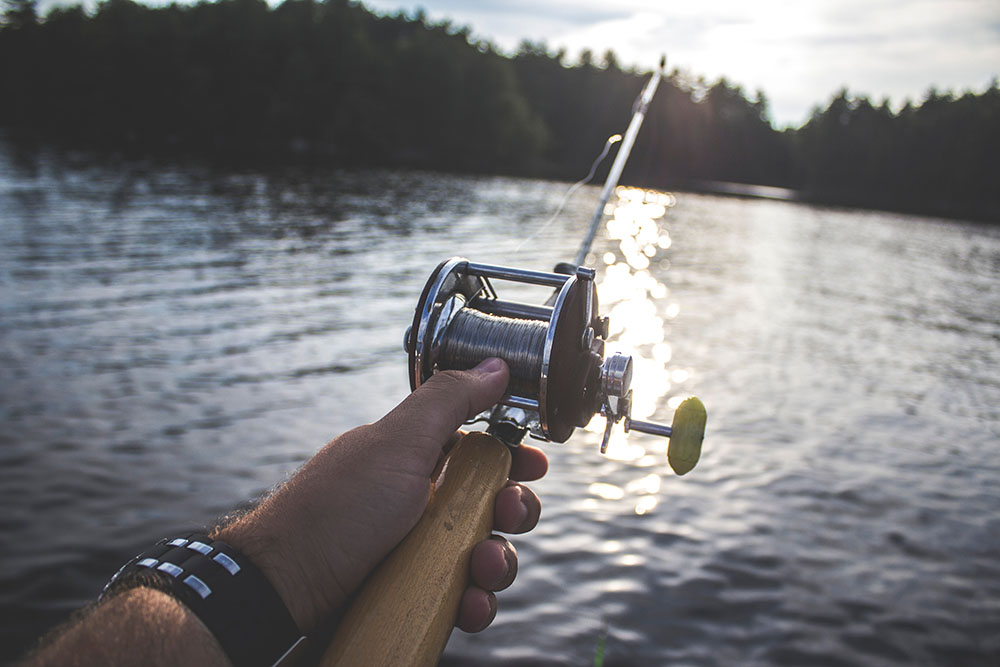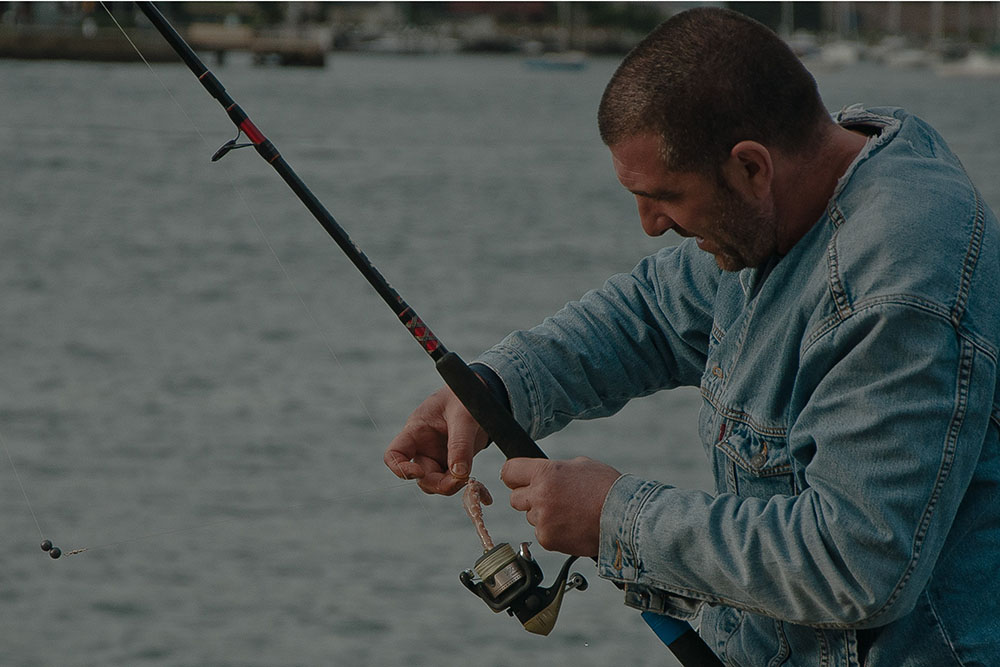The line you use on your baitcaster is typically a personal choice, and it depends entirely on your preferences and the type of fishing you do.
There are many different types of lines that you can use when finishing, but the three most commonly used are monofilament, fluorocarbon, and of course, braided.
To immediately get to the point and answer the question, yes you can put a braided line on a baitcaster.
However, a simple ‘yes’ will not suffice, and there is much to be explored regarding the use of a braided line on a baitcaster.

In today’s article, we are going to be exploring braided lines, looking at why you may want to use it on a baitcaster, and letting you know some important information about it.
This article will be ideal for you if you are looking for a new line, or have considered trying a braided line for your baitcaster.
So, what exactly is a braided line, and how does it differ from other lines?
Before we explore the use of a braided line on a baitcaster any further, we must first explore what exactly a braided line is and how it differs from the other types of fishing line out there.
The braided line was one of the first types of fishing line used, and its popularity has remained as it is still one of the most popular fishing lines to use today.
In the past, they would be made from natural fibers such as cotton, silk, and linen but these days they are more likely to be made from manmade fibers that promise a little more durability (as well as being cheaper).
It gets its name from the fact that it is braided. Thin fibers are braided together to form a bigger, thicker, and stronger piece.
What sets it apart from other lines, such as monofilament and fluorocarbon is the fact that in comparison it has a much smaller diameter.
This means that generally, you can get more of it on to your reel. This is particularly important for deep-sea fishing and any sort of fishing in deepwater.
They are also far more sensitive compared to the other types of lines. This is especially needed if you are fishing for fish that may have a more gentle bite, or if you are targeting smaller fish.
Why should I use them on a baitcaster?
Baitcasting is often used by experienced anglers who are aiming to catch some bigger fish.
It is a common choice of reel for those who often fish in rough weather, with choppy waters and high winds.
Braided lines compliment baitcaster really well because they are excellent lines to use to be able to withstand harsh weather conditions.
They are less likely to be carried away by strong currents, for example. As well as this, they are made to be very strong and durable, and they have a very low resistance to breakages and abrasion.
As we mentioned, baitcasting is often the best choice if you are aiming to catch bigger fish and deep-sea creatures. using a braided line can help you to do this more successfully.
This is because a braided line is often the best choice for heavy fish, with the ability to withstand weights up to around 50lbs!
Also, the fact that it has a much smaller diameter than other lines means that you can fit more of it onto a reel.
This is particularly important if you are going to be needing a lot of lines, for example, in deep water conditions.
As well as this, baitcasters used for trolling are often lined with braided lines. This is because a braided line allows you to cast harder, to get a better distance, and holds more weight.
The fact that they allow for increased sensitivity is yet another reason why braided lines are so popular.
The reason for this sensitivity is because a braided line has a very little stretch.
This lack of stretch means that you can feel everything, and even on the slightest nibble, you will likely feel the line getting very taut.
When fishing for fish that have a notoriously gentle bite, like the walleye, panfish, and even the bass, it can be very difficult to know exactly whether they have gone for the bite.
Choosing a line that is sensitive can allow you to feel this bite much easier, and it will feel a little more defined.
Gone are the days when you miss a big catch because you couldn’t feel it - a braided line might just solve that problem!
Another reason this type of line is commonly used is that it floats well and is a little more buoyant than some of the other line choices available.
If you are planning to use your baitcaster for topwater fishing and frog fishing, then you should certainly consider using a braided line.
The lack of stretch in a braided line actually works in your favor when it comes to this kind of fishing, especially when you are using floating lures like frog lures.
Are there any downsides to using braided lines?
Let’s face it, not everything can be perfect. As with all fishing lines, some are better suited for certain conditions than others.
Whilst many anglers swear by a braided line, many others avoid it.
One of the main reasons for this is the fact that a braided line is often far more visible than the other line options available to us.
Whilst this might be great for us because we know exactly where the line is and can keep an eye on it, it may work to our disadvantage at times.
It is thought that some fish can have around 4 or 5 times better vision than us. Many fish, take the example of walleyes, have adapted so that they can see very well even in low light.
This means that they see the line we have cast. Them seeing the line might warn them that something is amiss, scaring off the fish.
Of course, this situation wholly depends on the type of weather you are fishing in. if the water is very clear, then a braided line will be able to be seen more visibly.

However, if the water is murky, as it often is deep down in lakes, the clarity of the water is affected and the fish may not notice the line.
A great fix you can utilize if you are worried about your braided line being too visible is to attach a monofilament line onto the end of it, or to use a leader.
This will mean that your fish is less likely to see the visible braided line, and will be more likely to snap onto your lure.
Another downside that may put off anglers and fishermen is the fact that braided lines can be a little more difficult to knot.
Many anglers who have used the braided line for the first time and found that their knots came loose have been put off using it again.
Whilst this is a fair criticism, it must be noted that because it is tougher to knot, there are only a small number of knots that can be utilized successfully.
If these knots are not used then it is likely they will come loose.
To fix the problem, ensure you use the knots that are recommended such as the Alberto knot, the Berkely braid knot, and the Double Palomar Knot, among others.
Whilst a braided line is generally very durable, and very resistant to abrasion and breakage from excessive wear, the fact that it has next to no stretch and no shock absorption can actually be seen as a downside at times.
This is because of the lack of ‘give’ that the line gives you. This means that if you get a fish that is particularly hard-hitting on your line, it may be more likely to break, especially if you were not ready and did not expect it.
The fact that there is no stretch and leeway means that the line can snap if you get a bite from a particularly big fish and you try to pull it up with too much force.
There is a knack for pulling the line back in properly, hence why it is most often used by experienced anglers rather than beginners.
Final verdict
So, to answer the question posed at the beginning of the article: yes, you certainly can put a braided line on a baitcaster.
As with most things in life, the choice is a personal one.
Every angler has their preferences, and it depends on many factors such as what you are fishing for, where you are fishing, and the conditions of the water and weather when you are fishing.
We are sure that you can tell by now that there are indeed some situations that would be highly benefited by the use of braided line in a baitcaster.
They are an excellent choice for any deepwater fishing, especially if the fish in question are large or have a gentle bite.
This is because of the increased sensitivity of a braided line and the fact that it can hold more weight than other line types.
A braided line also has a much smaller diameter than that of monofilament or fluorocarbon, and so you can often fit more of it onto a reel.
Because of the fact that it floats well, braided lines are also a great choice for topwater fishing and frogging.
As with anything, though, there are some downsides.
For example, it is much more visible than the other two main types of lines, and so it is more likely to be seen by your fish in clear waters.
As well as this it is also a little more difficult to knot and prone to snapping if too much force is used for a big bite.
As we have said, it most certainly comes down to your own preferences, but in our opinion, the pros certainly far outweigh the cons, and we truly think that a braided line is an excellent choice for fishing with a baitcaster!
- 10 Best Trolling Motor Batteries: Top AGM and Flooded Options - January 27, 2021
- Types of Fishing Lures - January 22, 2021
- 8 Best Batteries For Fish Finders - January 22, 2021
